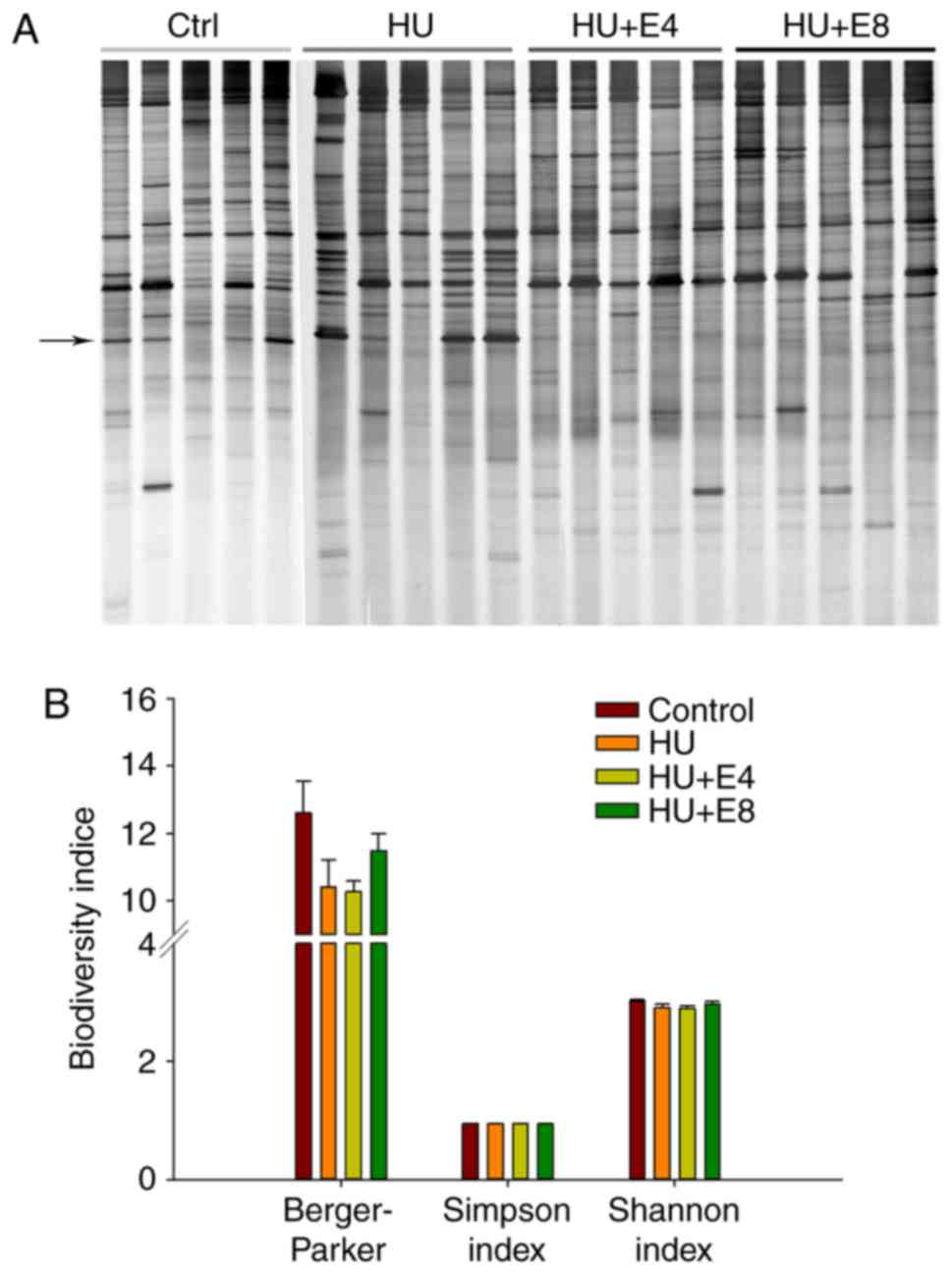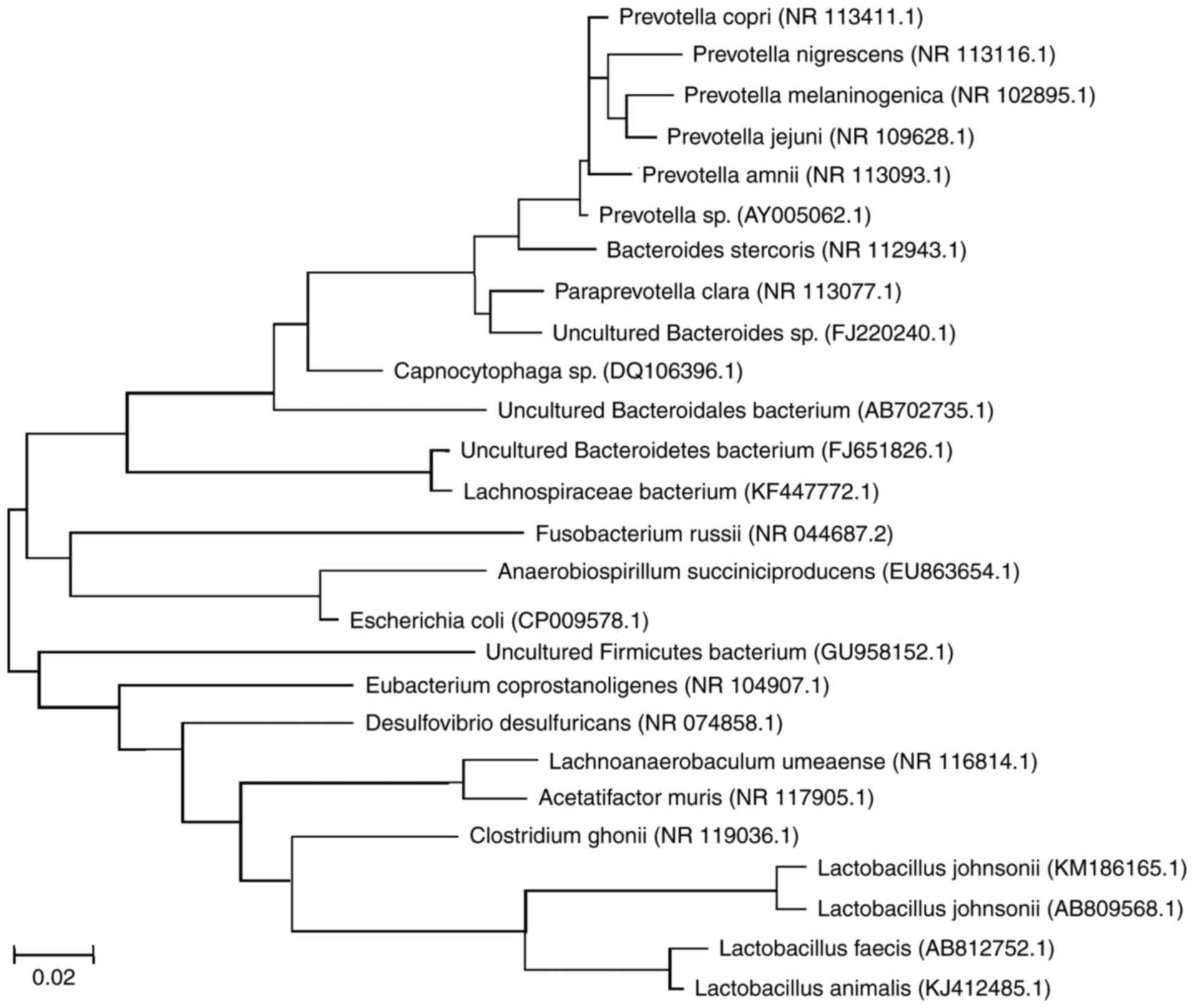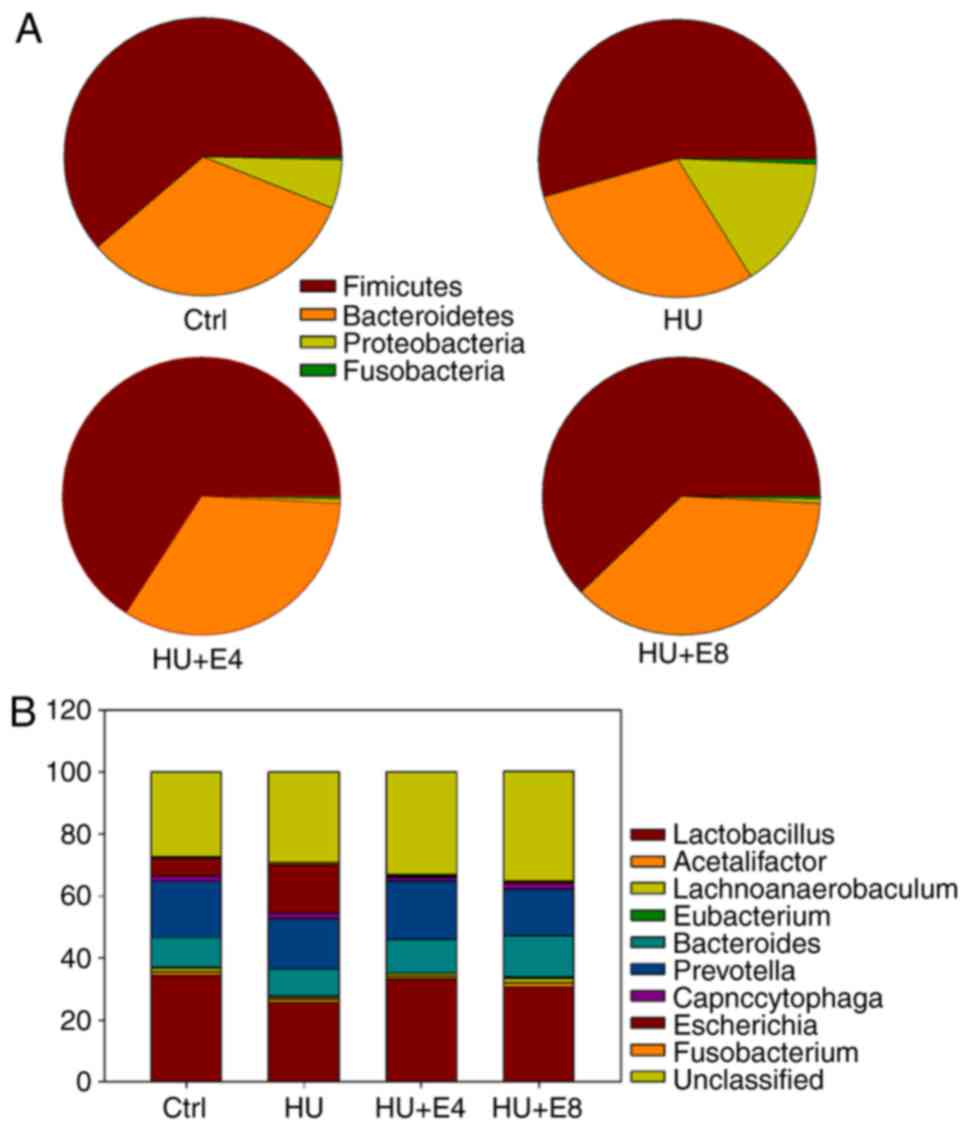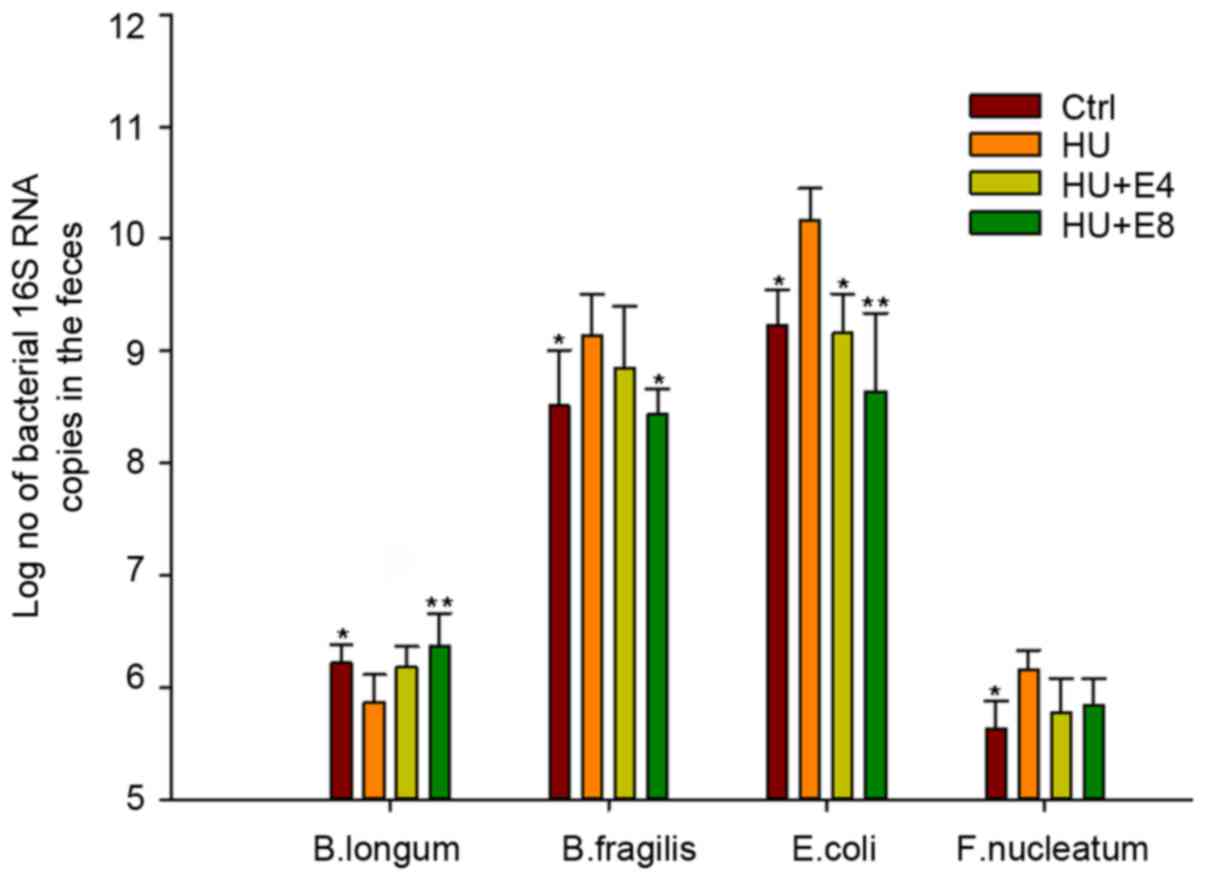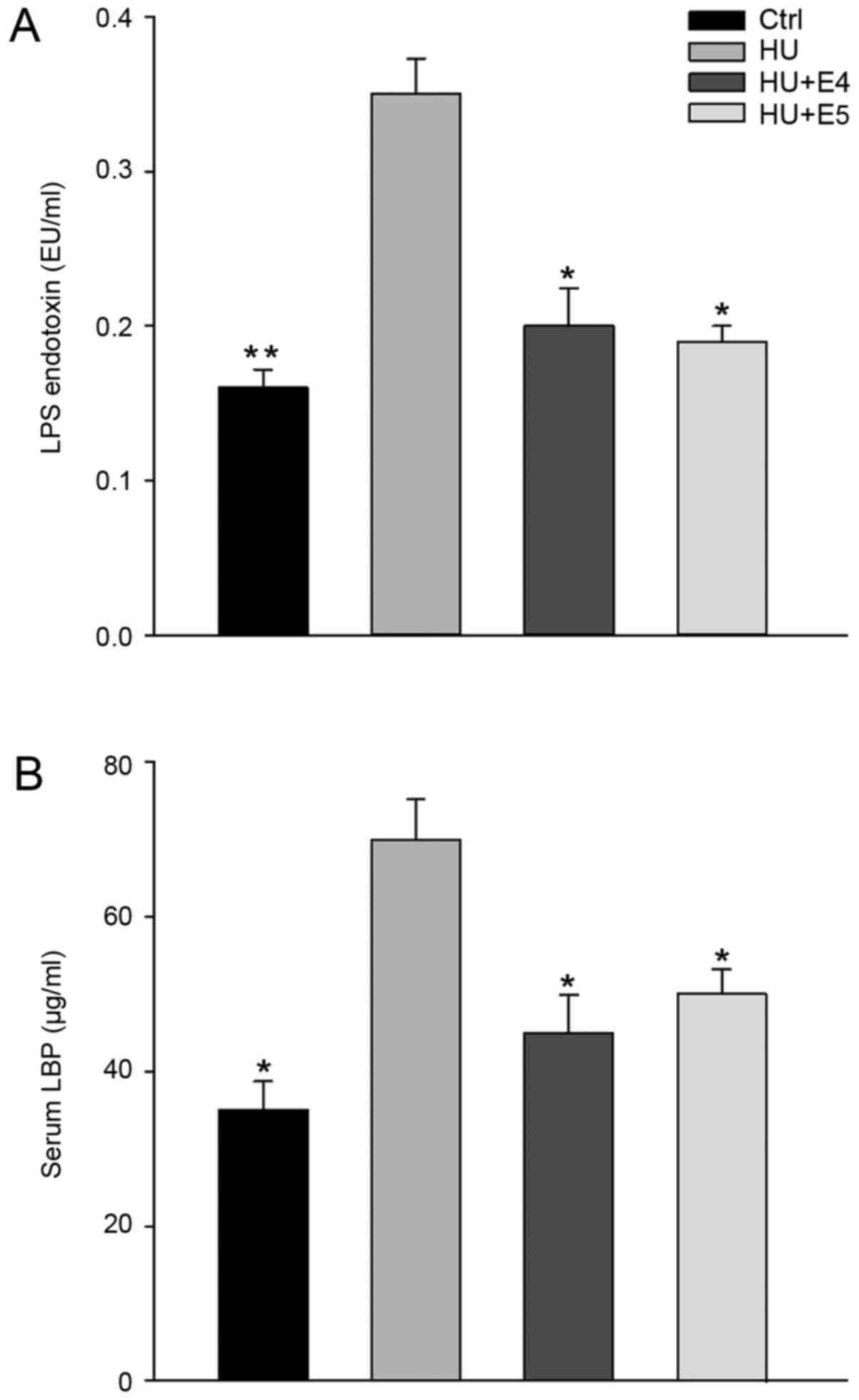|
1
|
Saei AA and Barzegari A: The microbiome:
The forgotten organ of the astronaut's body-probiotics beyond
terrestrial limits. Future Microbiol. 7:1037–1046. 2012. View Article : Google Scholar : PubMed/NCBI
|
|
2
|
Cervantes JL and Hong BY: Dysbiosis and
immune dysregulation in outer space. Int Rev Immunol. 35:67–82.
2016.PubMed/NCBI
|
|
3
|
Tou JC, Grindeland RE and Wade CE: Effects
of diet and exposure to hindlimb suspension on estrous cycling in
Sprague-Dawley rats. Am J Physiol Endocrinol Metab. 286:E425–E433.
2004. View Article : Google Scholar : PubMed/NCBI
|
|
4
|
Neuman H, Debelius JW, Knight R and Koren
O: Microbial endocrinology: The interplay between the microbiota
and the endocrine system. FEMS Microbiol Rev. 39:509–521. 2015.
View Article : Google Scholar : PubMed/NCBI
|
|
5
|
Li P, Shi J, Zhang P, Wang K, Li J, Liu H,
Zhou Y, Xu X, Hao J, Sun X, et al: Simulated microgravity disrupts
intestinal homeostasis and increases colitis susceptibility. FASEB
J. 29:3263–3273. 2015. View Article : Google Scholar : PubMed/NCBI
|
|
6
|
Ritchie LE, Taddeo SS, Weeks BR, Lima F,
Bloomfield SA, Azcarate-Peril MA, Zwart SR, Smith SM and Turner ND:
Space environmental factor impacts upon murine colon microbiota and
mucosal homeostasis. PLoS One. 10:e01257922015. View Article : Google Scholar : PubMed/NCBI
|
|
7
|
Zhou Y, Ni H, Li M, Sanzari JK,
Diffenderfer ES, Lin L, Kennedy AR and Weissman D: Effect of solar
particle event radiation and hindlimb suspension on
gastrointestinal tract bacterial translocation and immune
activation. PLoS One. 7:e443292012. View Article : Google Scholar : PubMed/NCBI
|
|
8
|
Looijer-van Langen M, Hotte N, Dieleman
LA, Albert E, Mulder C and Madsen KL: Estrogen receptor-β signaling
modulates epithelial barrier function. Am J Physiol Gastrointest
Liver Physiol. 300:G621–G626. 2011. View Article : Google Scholar : PubMed/NCBI
|
|
9
|
Menon R, Watson SE, Thomas LN, Allred CD,
Dabney A, Azcarate-Peril MA and Sturino JM: Diet complexity and
estrogen receptor β status affect the composition of the murine
intestinal microbiota. Appl Environ Microbiol. 79:5763–5773. 2013.
View Article : Google Scholar : PubMed/NCBI
|
|
10
|
Wang MH and Achkar JP: Gene-environment
interactions in inflammatory bowel disease pathogenesis. Curr Opin
Gastroenterol. 31:277–282. 2015. View Article : Google Scholar : PubMed/NCBI
|
|
11
|
Walter J and Ley R: The human gut
microbiome: Ecology and recent evolutionary changes. Annu Rev
Microbiol. 65:411–429. 2011. View Article : Google Scholar : PubMed/NCBI
|
|
12
|
Benson AK, Kelly SA, Legge R, Ma F, Low
SJ, Kim J, Zhang M, Oh PL, Nehrenberg D, Hua K, et al:
Individuality in gut microbiota composition is a complex polygenic
trait shaped by multiple environmental and host genetic factors.
Proc Natl Acad Sci USA. 107:pp. 18933–18938. 2010; View Article : Google Scholar : PubMed/NCBI
|
|
13
|
Du F, Ding Y, Zou J, Li Z, Tian J, She R,
Wang D, Wang H, Lv D and Chang L: Morphology and molecular
mechanisms of hepatic injury in rats under simulated weightlessness
and the protective effects of resistance training. PLoS One.
10:e01270472015. View Article : Google Scholar : PubMed/NCBI
|
|
14
|
Zhang R, Ran HH, Cai LL, Zhu L, Sun JF,
Peng L, Liu XJ, Zhang LN, Fang Z, Fan YY and Cui G: Simulated
microgravity-induced mitochondrial dysfunction in rat cerebral
arteries. FASEB J. 28:2715–2724. 2014. View Article : Google Scholar : PubMed/NCBI
|
|
15
|
Su Y, Yao W, Perez-Gutierrez ON, Smidt H
and Zhu WY: 16S ribosomal RNA-based methods to monitor changes in
the hindgut bacterial community of piglets after oral
administration of Lactobacillus sobrius S1. Anaerobe. 14:78–86.
2008. View Article : Google Scholar : PubMed/NCBI
|
|
16
|
Breton J, Massart S, Vandamme P, De Brandt
E, Pot B and Foligné B: Ecotoxicology inside the gut: Tmpact of
heavy metals on the mouse microbiome. BMC Pharmacol Toxicol.
14:622013. View Article : Google Scholar : PubMed/NCBI
|
|
17
|
Lozupone CA and Knight R: Species
divergence and the measurement of microbial diversity. FEMS
Microbiol Rev. 32:557–578. 2008. View Article : Google Scholar : PubMed/NCBI
|
|
18
|
Xu M, Wang B, Fu Y, Chen Y, Yang F, Lu H,
Chen Y, Xu J and Li L: Changes of fecal Bifidobacterium species in
adult patients with hepatitis B virus-induced chronic liver
disease. Microb Ecol. 63:304–313. 2012. View Article : Google Scholar : PubMed/NCBI
|
|
19
|
Chen Y, Yang F, Lu H, Wang B, Chen Y, Lei
D, Wang Y, Zhu B and Li L: Characterization of fecal microbial
communities in patients with liver cirrhosis. Hepatology.
54:562–572. 2011. View Article : Google Scholar : PubMed/NCBI
|
|
20
|
Du Plessis J, Vanheel H, Janssen CE, Roos
L, Slavik T, Stivaktas PI, Nieuwoudt M, van Wyk SG, Vieira W,
Pretorius E, et al: Activated intestinal macrophages in patients
with cirrhosis release NO and IL-6 that may disrupt intestinal
barrier function. J Hepatol. 58:1125–1132. 2013. View Article : Google Scholar : PubMed/NCBI
|
|
21
|
Barman M, Unold D, Shifley K, Amir E, Hung
K, Bos N and Salzman N: Enteric salmonellosis disrupts the
microbial ecology of the murine gastrointestinal tract. Infect
Immun. 76:907–915. 2008. View Article : Google Scholar : PubMed/NCBI
|
|
22
|
Lynch SV, Brodie EL and Matin A: Role and
regulation of sigma S in general resistance conferred by low-shear
simulated microgravity in Escherichia coli. J Bacteriol.
186:8207–8212. 2004. View Article : Google Scholar : PubMed/NCBI
|
|
23
|
Bailey MT, Dowd SE, Galley JD, Hufnagle
AR, Allen RG and Lyte M: Exposure to a social stressor alters the
structure of the intestinal microbiota: Implications for
stressor-induced immunomodulation. Brain Behav Immun. 25:397–407.
2011. View Article : Google Scholar : PubMed/NCBI
|
|
24
|
Rosenzweig JA, Abogunde O, Thomas K, Lawal
A, Nguyen YU, Sodipe A and Jejelowo O: Spaceflight and modeled
microgravity effects on microbial growth and virulence. Appl
Microbiol Biotechnol. 85:885–891. 2010. View Article : Google Scholar : PubMed/NCBI
|
|
25
|
Allen CA, Niesel DW and Torres AG: The
effects of low-shear stress on Adherent-invasive Escherichia coli.
Environ Microbiol. 10:1512–1525. 2008. View Article : Google Scholar : PubMed/NCBI
|
|
26
|
Zhang YJ, Li S, Gan RY, Zhou T, Xu DP and
Li HB: Impacts of gut bacteria on human health and diseases. Int J
Mol Sci. 16:7493–7519. 2015. View Article : Google Scholar : PubMed/NCBI
|
|
27
|
Gombošová L, Lazúrová I, Zakuciová M,
Curová K, Kmeťová M, Petrášová D and Siegfried L: Genes of
intestinal Escherichia coli and their relation to the inflammatory
activity in patients with ulcerative colitis and Crohn's disease.
Folia Microbiol (Praha). 56:367–372. 2011. View Article : Google Scholar : PubMed/NCBI
|
|
28
|
Arunasri K, Adil M, Venu Charan K, Suvro
C, Himabindu Reddy S and Shivaji S: Effect of simulated
microgravity on E. Coli K12 MG1655 growth and gene expression. PLoS
One. 8:e578602013. View Article : Google Scholar : PubMed/NCBI
|
|
29
|
Rubtsova K, Marrack P and Rubtsov AV:
Sexual dimorphism in autoimmunity. J Clin Invest. 125:2187–2193.
2015. View Article : Google Scholar : PubMed/NCBI
|
|
30
|
Yurkovetskiy L, Burrows M, Khan AA, Graham
L, Volchkov P, Becker L, Antonopoulos D, Umesaki Y and Chervonsky
AV: Gender bias in autoimmunity is influenced by microbiota.
Immunity. 39:400–412. 2013. View Article : Google Scholar : PubMed/NCBI
|
|
31
|
Xavier RJ and Podolsky DK: Unravelling the
pathogenesis of inflammatory bowel disease. Nature. 448:427–434.
2007. View Article : Google Scholar : PubMed/NCBI
|
|
32
|
Bashir A, Miskeen AY, Bhat A, Fazili KM
and Ganai BA: Fusobacterium nucleatum: An emerging bug in
colorectal tumorigenesis. Eur J Cancer Prev. 24:373–385. 2015.
View Article : Google Scholar : PubMed/NCBI
|
|
33
|
Sears CL, Geis AL and Housseau F:
Bacteroides fragilis subverts mucosal biology: From symbiont to
colon carcinogenesis. J Clin Invest. 124:4166–4172. 2014.
View Article : Google Scholar : PubMed/NCBI
|
|
34
|
Castellarin M, Warren RL, Freeman JD,
Dreolini L, Krzywinski M, Strauss J, Barnes R, Watson P,
Allen-Vercoe E, Moore RA and Holt RA: Fusobacterium nucleatum
infection is prevalent in human colorectal carcinoma. Genome Res.
22:299–306. 2012. View Article : Google Scholar : PubMed/NCBI
|
|
35
|
Mermel LA: Infection prevention and
control during prolonged human space travel. Clin Infect Dis.
56:123–130. 2013. View Article : Google Scholar : PubMed/NCBI
|



